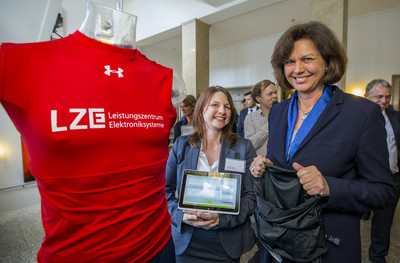Fascinating clean room at Fraunhofer IISB
Kevin Ehrensberger completed his vocational training as microtechnologist at Fraunhofer IISB in September 2021. The former nanotechnology student has one thing in common with his colleagues Nadine Riek and Stefanie Schickedanz: "I also wanted to work with my hands, something in relation to reality." The small but significant word "also" is elementary in this sentence. To practice their profession, microtechnologists dive deep into the micro- and nanostructures of computer chips and semiconductor components, both theoretically and practically.
Stephanie Natzer, instructress at Fraunhofer IISB, explains why this varied profession has such a bright future: “Microtechnologists know how to create these tiny marvels and experience this technological progress in real time, so to say."
As microtechnologist you belong to an exclusive club
From cell phones, battery charging systems and cars to airplanes and satellites - digitization and the Internet of Things are spurring the development of increasingly powerful devices and components. The need for efficiently switching power components to convert electrical energy is growing as well. This is one of the main emphases of the Fraunhofer IISB, Institute for Integrated Systems and Device Technology based in Erlangen. Trough research and development on power electronics, semiconductor technology and materials, it supports important industries such as energy technology, photovoltaics or e-mobility.
There are six technical departments at Fraunhofer IISB. Nadine is one of seven current microtechnology trainees and learns how to assemble electronic components along with mounting circuit boards in the packaging technology laboratory. The online tender for this apprenticeship had spontaneously piqued her interest. "This profession is still young. It's not something you specifically look for. We are quite an exclusive club" Nadine says. Only 17 other apprentices from all over Bavaria sit together with her in the vocational school class.
With her passion for chemistry, she already fulfilled a large part of the suitability profile. Nevertheless, you should also be comfortable with math, physics and English. Before starting her apprenticeship, Nadine didn't really know what to expect. "I think it's great that we go through all the departments here. In the workshop, we learn how to fabricate workpieces according to technical drawings, and in the clean room we learn everything about the manufacturing processes for integrated circuits, such as lithography, ion implantation, dry and wet etching, thermal oxidation or metallization."
Not only clean, but pure!
The Semiconductor Devices department at Fraunhofer IISB has various focal points, including the development of sensor devices and power devices based on silicon and silicon carbide. The latter are switching components used to control electrical machines in e-vehicles, for example. In Fraunhofer IISB's high-tech clean rooms, the entire process spectrum for manufacturing components can be mapped. Teams from various scientific and engineering disciplines develop holistic solutions here for customers from industry, starting with design, feasibility studies and prototyping up to the manufacturing process. "As microtechnologist, I take care of the implementation and control of the manufacturing processes" Kevin explains.
He works in the field of photolithography and spends most of his working time in the institute's clean rooms on the Erlangen high-tech campus of the FAU. Fraunhofer IISB maintains the largest clean room together with the neighboring Chair of Electronic Devices. Even the tiniest dust particles can lead to defective components, which is why the air in the clean room is permanently filtered and recirculated. "We wear coveralls, headgear, gloves and face masks so that we don't introduce particles under any circumstances"Kevin continues. Even the use of lights is strictly regulated. Photolithography is a key process step in the manufacture of integrated circuits. Exposure processes are used to create patterned photoresist layers on a silicon wafer. To prevent the light-sensitive photoresist from developing in an uncontrolled manner, only yellow light without blue light components is allowed to illuminate the workplace."I found the clean room absolutely crazy when I was looking for an apprenticeship, so I really wanted to learn more about it" Nadine interjects.
The true Silicon Valley lies in the Nuremberg Metropolitan Region
The Nuremberg metropolitan region is convinced that the Franconian Switzerland is home to the true Silicon Valley. The Siemens semiconductor research laboratory was housed in Pretzfeld Castle in 1946 and served as the setting for a groundbreaking invention that made it possible to manufacture semiconductors and thus ushered in the era of microelectronics. In the mid-1950s, the production of monocrystalline hyper pure silicon succeeded here. Emerging from this history, a technological-scientific network of companies and research institutions has formed in the Nuremberg Metropolitan Region around integrated circuits, power electronics, semiconductors and nanotechnology. Resultingly, today's microtechnologists at Fraunhofer IISB are experiencing further development of processes and materials for ever smaller and more powerful components live.
"Our profession is very popular for young women," Stefanie Schickedanz tells and continues: "We are all a bit nerdy in a positive sense. We want to fundamentally understand the technologies we work with. Solving a problem for the sake of the problem is a motivation that drives many people in technology and science."- Nadine adds,"Even as trainees, we are often given team tasks or being asked how we would solve something. You are taken serious right from the start."
Working with a machine park that is unique all over Europe
Stefanie completed her apprenticeship in the field of industry. Today, she trains microtechnologists in the Packaging and Interconnection Technology department. Up to this day, she has never regretted her move to the renowned research institute. "I am professionally challenged here. The work is very diversified and often not only my skills but also my creativity is asked. Writing programs and presentations, maintaining equipment - it's all included."
Stefanie's field of activity is part of microsystems technology and deals with all kinds of processes for assembling electronic and non-electronic micro-components into a functioning system. In her AVT clean room in Erlangen, a fleet of equipment is available at her disposal that is unique not only in the Nuremberg metropolitan region, but throughout Europe. Stencil printers, inkjet printers, presses for metal sintering and soldering, wire & die bonders, equipment for subtractive as well as additive manufacturing and many more enable the production-oriented manufacturing of prototypes or small series. "As microtechnologists we know exactly what's going on in our equipment. We're often present during customer meetings so that we can provide important input on process performance and suitability" she explains. "It also makes sense to involve us technicians from the beginning when designing and laying out new equipment for future applications," Kevin adds.
Investigating the matter of future technologies thoroughly
Manufacturing capacities for chip fabrication are currently being built up throughout Europe. In the vicinity of these mega-factories, technology clusters are emerging - as in the Nuremberg metropolitan region - where experienced specialists are sought around topics like semiconductors, integrated circuits and microsystems technology. Microtechnology is important for practically every key technology, and skilled workers are in hot demand. Based on their successfully completed apprenticeship, Stefanie and Kevin have laid a solid foundation for their future careers and are already on their way to the next level: both are taking further training as electrical engineers.
Which innovations would these three like to see in the future? What needs to be researched? What is their professional motivation? Stefanie: "I think sustainable energies in general and energy storage in particular are of utmost importance." - Nadine: "I want to work in a varied profession and help shape projects." - Kevin:"I love working in applied research, where I can actively contribute to the development of future technologies."




